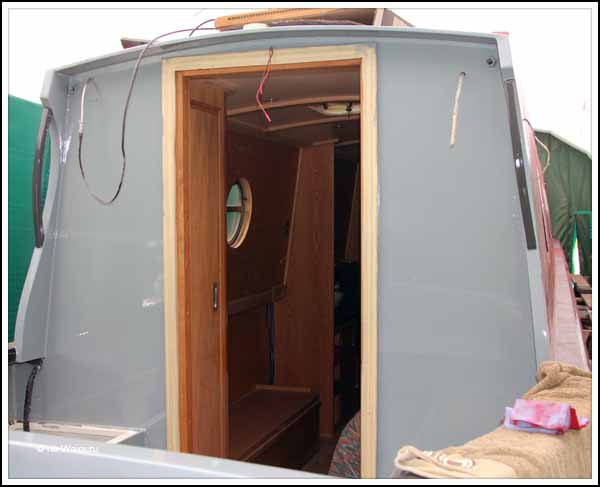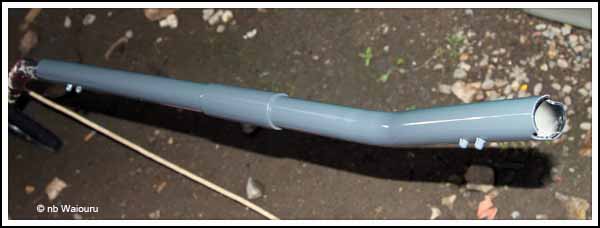Waiouru has three diesel tanks and two diesel gauges. The gauges are for the two tanks in the stern. One tank is for propulsion and the other for the Hurricane heater. The gauges are from
MSC and are digital. They work on air pressure and this requires a copper pipe be run from the sender unit to the amplifier. From there the connection is electrical to the gauge in the back cabin.
Nick was in a slight quandary about where to fit the sender units into each tank. His first task was to establish where the partition was between the two tanks. His investigation resulted in him confirming my advice that the Hurricane tank is about a third of the size of the engine tank. Eventually Nick decided to fit the sender units into each tank via the weed hatch. Tyler-Wilson shells have a non-flooding weed hatch accessible from the rear deck.
View into the weed hatch from the cockpit.
The engine sender is in the top left of the photo and the Hurricane sender in the top right. Each sender turns 90° so the pipe will go vertically to the bottom of the tank. The pipes exit the weed hatch via a waterproof gland in the bottom right of the photo.
A better view of the Hurricane sender and the exit gland.
Nick has covered the copper pipes with a thick rubber sleeve to give them some protection.
The pipes enter the engine compartment to the right of the domestic battery bank and then go up into the control column where they connect into an amplifier.
Nick feeds the pipes up into the control column
Nick connects the pipes to the amplifiers.
The expensive part of the task has yet to occur…… The calibration! The gauges work on air pressure which requires an air bubble in the sender. This is achieved by ‘pumping up’ the gauge with a bicycle pump. However the calibration can’t be done unless the tanks are FULL! So we face the expensive exercise of filling all our diesel tanks for the first time
<ouch!>
Mid-morning the Royal Mail van arrived with the satellite coaxial cables I had ordered from
ATV. They have been custom made to length with ‘F’ connectors on each end. One cable is 2.5m long and the other 4 metres. The short of the two runs from the satellite dome position on the roof to the media centre beside the diesel stove. When
Waiouru was a shell I purchased some flexible conduit from Screwfix and installed it in the ceiling. Then I ran draw wires through the conduit so the coaxial (and other cables) could be installed after
Waiouru’s ceiling had been fitted. Getting the 2.5m coaxial through the conduit between the position of the dome and the media centre wasn’t too difficult.
As you can see in the above photo the coaxial exits the roof in the centre of the dome mountings. A small block of wood has been taped to it to prevent the cable accidentally being pulled back into the conduit. Eventually it will have a terminal cap over the hole in the roof. However this will not be done until I’ve confirmed there is sufficient cable for the connection to the dome
(the dome is currently on our ‘wish list’… and not at the top!).
The connection at the other end is in the media centre.
This is the top compartment which has a small door to conceal the contents. The purpose of the compartment is to hold 240v & 12v power connections and power transformers. The satellite dome receiver will go in the compartment underneath along with the Network Media Tank.
I had a problem with the second coaxial cable. It runs from the media centre through a conduit in the ceiling cavity to the edge of the roof and then drops down through a void in the wall of the display cabinet to the TV. The problem was the coaxial couldn’t be pulled though the conduit using the draw wire. The hole in the ceiling lining wasn’t directly below the mouth of the conduit and I couldn’t get my finger far enough into the hole to discover what was obstructing the cable. In the end I used Richard’s oscillating saw and cut a groove in the ceiling lining (photo above). This isn’t a problem as the compartment will usually be closed. However I can always fit a new section of ceiling ply over the groove if it concerns me! Cutting the groove enabled me to identify the problem as a second cable in the conduit. Actually there was sufficient room in the conduit for both the coaxial and the other cable except the coaxial had an ‘F’ connector on the end. The solution was to remove the second cable (a 12v feed to the satellite receiver) and tape a second draw wire to the coaxial. I could then pull the coaxial through the conduit to the display cabinet and use the draw wire to pull the 12v power cable back (plus another draw wire in case it is needed at some future date).

Then a second draw wire was used to pull the coaxial down to the TV bracket.
The right angle ‘F’ connector.
We now have all the wiring for the media system installed. The Sat-dome cable runs to the receiver and then to the main TV which has a built-in FreeSat tuner. The Terrestrial aerial runs from the forward bulkhead fitting into the wardrobe where it connects to a 12v amplifier. From there it goes to the TV cabinet and a three way splitter. One cables goes back to the small TV in the bedroom; another to the Network Media Tank (NMT); and the third goes to the main TV. There is a HDMI cable from the NMT to a splitter in the display cabinet. From there one HDMI cable goes to the small TV in the bedroom and a second to the main TV.
After lunch a courier arrived at the yard with the mobile phone holder we ordered from eBay. We had become concerned about the number of times the smartphone had fallen on the floor. As the phone is our principle means of communication (voice and date) we needed to secure it; but also make it readily accessible. Hence the decision to purchase the holder. It was rather cheap, (less than £5) and is designed to fit on the windscreen of a vehicle.
Obviously the plastic suction cap on the base wouldn’t work on the varnished timber but that was easily solved with the drill and a couple of screws. All we now need is a couple of clothes hooks which I’ll fit under the shelf (red arrow) at either end. We will then be able to secure the surplus exterior aerial cable around the hooks. The cable can’t be shortened as we sometimes need to hold the phone to make voice calls from inside
Waiouru.
The last task for the day was to sand down and clean the timber in the back cabin ready for a second coat of varnish. Jan and I plan to work our way through
Waiouru compartment by compartment giving all the timber a second coat. So tomorrow may see us sanding the galley and varnishing the back cabin.
















































